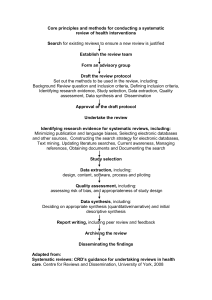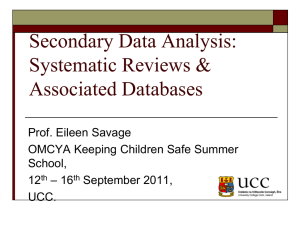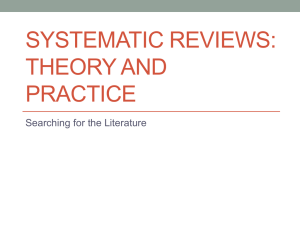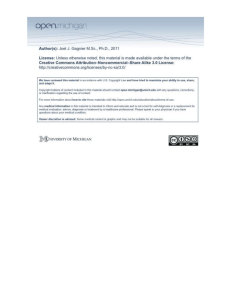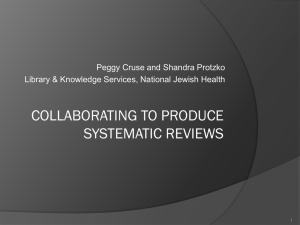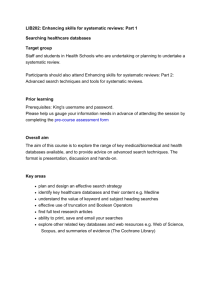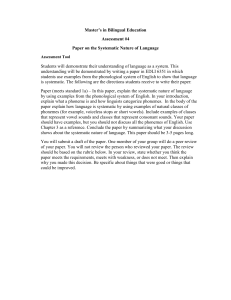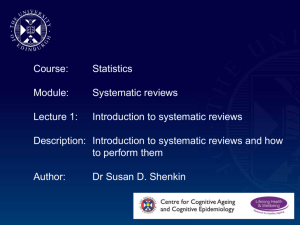presentation
advertisement
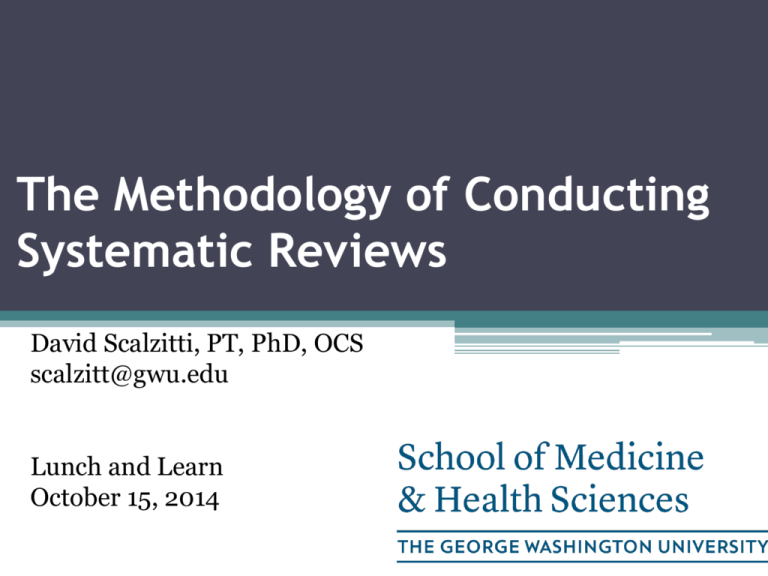
The Methodology of Conducting Systematic Reviews David Scalzitti, PT, PhD, OCS scalzitt@gwu.edu Lunch and Learn October 15, 2014 Key Points • Identify the uses of systematic reviews • Differentiate systematic reviews, metaanalyses, and clinical practice guidelines • Identify/perform valid methods for a systematic review Relative Hierarchy of Intervention Evidence based on www.cebm.net • Systematic reviews of RCTs • Randomized controlled trials or an observational study with dramatic effect • Cohort study • Case-control study or Case series • Mechanism-based reasoning Systematic Review A summary of the medical literature that uses EXPLICIT methods to perform a thorough literature search AND critical appraisal of individual studies AND that uses appropriate techniques to combine these valid studies. Meta-Analysis A systematic review that incorporates a quantitative strategy for combining the results of several studies into a single pooled or summary estimate. All MA should be based on a SR. All SR do not include a MA. Clinical Practice Guideline Systematically developed statements to assist practitioner and patient decisions about appropriate health care for specific clinical circumstances. All clinical practice guidelines should include a systematic review of the literature PLUS a recommendation. How I got involved PRISMA • Preferred Reporting Items for Systematic Reviews and Meta-Analyses (PRISMA) • www.prisma-statement.org ▫ 27 item checklist ▫ Flow diagram PRISMA Define a Clinical Question - PICOTS • • • • • • P - Participants I - Interventions C - Comparisons O - Outcomes (T – Timing) (S – Setting or Study Design) Assemble a Team Develop the Protocol for the SR • Set inclusion/exclusion criteria • Define evaluation method • Draft evidence tables ▫ Good resource: Mlika-Cabanne N, Harbour R, de Beer H, Laurence M, Cook R, Twaddle S; Guidelines International Network (GIN) Working Group on Evidence Tables. Sharing hard labour: developing a standard template for data summaries in guideline development. BMJ Qual Saf. 2011 Feb;20(2):141-5. Develop the Search Strategy • Select keywords • Identify databases ▫ PubMed ▫ Scopus ▫ CINAHL ▫ SPORTDiscus ▫ Cochrane Controlled Trial Registry ((“Anterior cruciate ligament” [TW] OR “posterior cruciate ligament” [TW] OR “medial collateral ligament” [TW] OR “lateral collateral ligament” [TW] OR “tibial collateral ligament” [TW] OR “fibular collateral ligament” [TW] OR “posterolateral corner” [TW] OR “arcuate complex” [TW] OR “posteromedial corner” [TW]) OR ((knee joint [MH]) AND (ligaments, articular [MH] OR ACL [TW] OR PCL [TW] OR MCL [TW] OR LCL [TW] OR TCL [TW] OR FCL [TW]))) AND (physical therapy modalities [MH] OR recovery of function [MH] OR rehabilitation [MH] OR therapeutics [MH] OR “physical therapy” [TW] OR physiother* [TW] OR recovery [TW] OR restoration [TW] OR re-education [TW] OR early ambulation [MH] OR strengthening [TW] OR resistance training [MH] OR “resistance methods” [TW] OR exercise therapy [MH] OR biofeedback, psychology [MH] OR “neuromuscular electrical stimulation” [TW] OR pain management [MH] OR pain measurement [MH] OR mobilization* [TW] OR “continuous passive motion” [TW] OR manipulation, spinal [MH] OR ultrasonography [TW] OR ultrasound [TW] OR acupuncture [TW] OR laser* [TW] OR patient education as topic [MH] OR electrical stimulation [MH] OR electrical stimulation therapy [MH] OR Transcutaneous electric nerve stimulation [MH] OR taping [TW] OR bracing [TW] OR orthotic* [TW] OR weight-bearing [MH] OR Range of motion [MH] OR Treatment Outcome [MH] OR Exercise [MH] OR “physical therapy treatments” [TW] OR “training program” [TW]) ANY QUESTIONS? scalzitt@gwu.edu To be continued - November 5, 2014… Systematic Reviews Part 2 Translating Evidence to Practice and Policy
